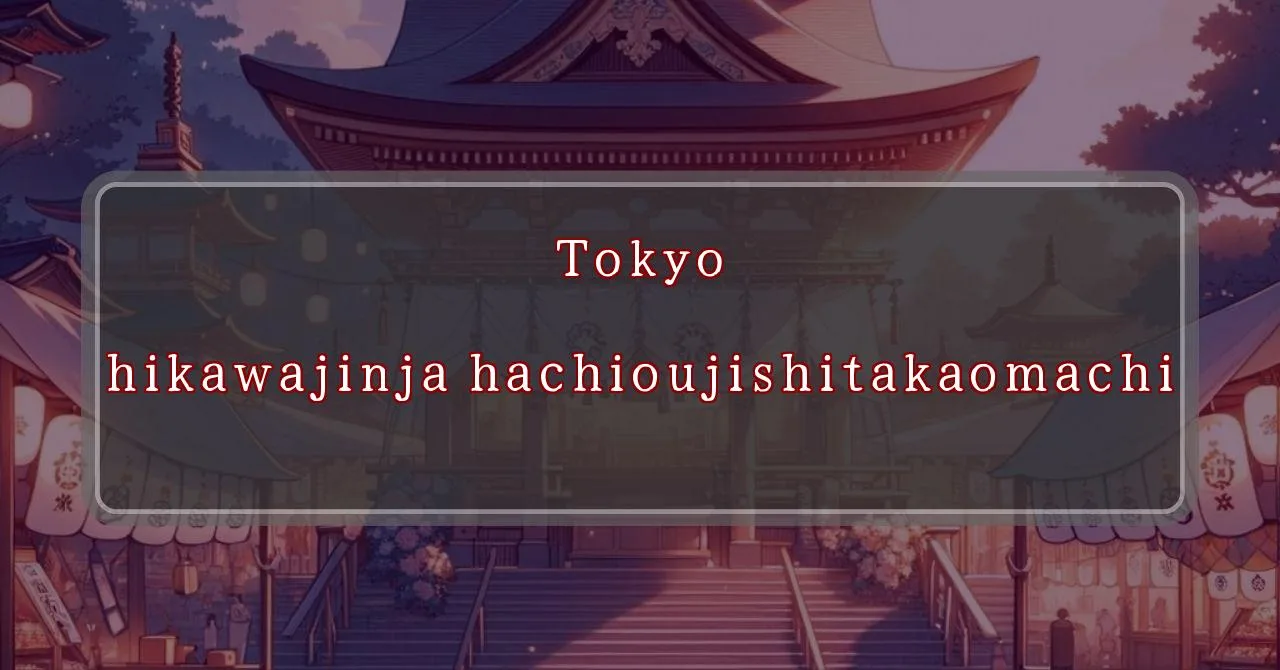Gleaming lights, divine spirits, and lively festivities
Basic Information
Hikawa Shrine is a Shinto shrine located in Takao-machi, Hachioji City, Tokyo, Japan. It is dedicated to the god Susanoo-no-Mikoto, who is revered for his association with agriculture, fishing, navigation, brewing, and as a god of production and prosperity.
- Address: 2258 Takao-machi, Hachioji-shi, Tokyo 193-0844, Japan
- Phone Number: 042-665-6288
- Access: 1-minute walk from Takao Yamaguchi Station on the Keio Line
- Festival Days: August 19th (Sat), August 20th (Sun), 2024
Main Events and Attractions of the Festival
The Hikawa Shrine Festival is a vibrant and lively event that attracts many visitors each year. The main events and attractions of the festival include:
Mikoshi Procession
One of the highlights of the festival is the mikoshi procession. A mikoshi is a portable shrine that is carried through the streets by a group of people. The mikoshi of Hikawa Shrine is particularly large and impressive, and it is carried by a team of over 100 people. The procession is a lively and colorful event, and it is a great opportunity to see the local community come together to celebrate.
Kagura Performance
Kagura is a traditional Japanese dance that is often performed at Shinto festivals. The kagura performance at the Hikawa Shrine Festival is a highlight of the event. The dancers wear elaborate costumes and perform a variety of dances, including the “shishimai” (lion dance) and the “kagura-mai” (sacred dance). The kagura performance is a beautiful and awe-inspiring sight, and it is a great way to learn about Japanese culture.
Bon Odori Dance
The bon odori dance is a traditional Japanese folk dance that is often performed during Obon, a Buddhist holiday that honors the spirits of the dead. The bon odori dance at the Hikawa Shrine Festival is a lively and energetic event, and it is a great way to experience Japanese culture. Visitors are encouraged to join in the dance, and there are many opportunities to learn the steps.
Food and Games
The Hikawa Shrine Festival also features a variety of food and games. There are many food stalls selling traditional Japanese dishes, such as yakitori (grilled chicken skewers), takoyaki (octopus balls), and kakigori (shaved ice). There are also a variety of games and activities for children, such as goldfish scooping and ring toss.
Blessings and Deities
Hikawa Shrine is dedicated to the god Susanoo-no-Mikoto, who is revered for his association with agriculture, fishing, navigation, brewing, and as a god of production and prosperity. Susanoo-no-Mikoto is also known for his role in the famous Japanese myth of the slaying of the eight-headed serpent, Yamata-no-Orochi. Visitors to the shrine can pray for blessings in a variety of areas, including good harvests, safe travels, and success in business.
Origin and History
The origins of Hikawa Shrine are unclear, but it is believed to have been founded in the 14th century. The shrine was originally located in the village of Kunugida, but it was moved to its current location in Takao-machi in 1662. The shrine has been rebuilt several times over the centuries, most recently in 1952. Hikawa Shrine is a popular destination for pilgrims and tourists alike, and it is also a venue for a number of annual festivals, including the Hikawa Shrine Festival, which is held every August.
Tips and Notes for Visitors
Here are some tips and notes for visitors to Hikawa Shrine:
- The shrine is open daily from 9:00 AM to 5:00 PM.
- Admission to the shrine is free.
- Visitors are expected to dress and behave respectfully.
- Photography is permitted, but please be respectful of other visitors and avoid using flash photography.
- There is a small gift shop on the shrine grounds where visitors can purchase souvenirs.
Parking Information
There is a parking lot available for visitors to Hikawa Shrine. The parking lot is located a short walk from the shrine.
- The parking lot is open 24 hours a day.
- The parking fee is 500 yen per day.
- There are 60 parking spaces available.
Popular Stalls and Food Carts in Recent Years
| Type of Stall | Description |
|---|---|
| Takoyaki | A staple at Japanese festivals. Characterized by a crispy outside and a creamy inside. |
| Jaga Butter | A simple yet popular snack of hot potatoes lavishly topped with melted butter. |
| Baby Castella | Small castella cakes, sweet and fluffy treats enjoyed by children and adults alike. |
| Grilled Ayu with Salt | Fresh ayu fish grilled whole with salt, a savory taste of Japanese summer. |
| Shaapin | A unique gourmet item influenced by foreign cuisine, with a chewy skin wrapping the filling. |
| Okonomiyaki | A Japanese grilled dish where you often choose your own ingredients for a personalized flavor. |
| Cotton Candy | A fluffy, sweet snack that’s extremely popular with children. |
| Chocolate Banana | A banana coated in chocolate, a fun and visually appealing dessert. |
| Kushiyaki | Various types of ingredients skewered and grilled, an easy-to-enjoy snack. |
| Yakisoba | Fried noodles mixed with a special sauce, a fast food favorite in Japan. |



